Exploring the Impact of Effective Workplace Culture in Nursing
VerifiedAdded on 2022/10/04
|10
|2518
|14
Essay
AI Summary
This essay discusses the significant impact of effective workplace culture on various aspects of clinical nursing. It highlights how a positive workplace culture promotes patient-centeredness, lifelong learning, collaboration, leadership development, and the implementation of evidence-based practices. Furthermore, it fosters positive attitudes towards change, enhances patient safety and outcomes, and improves both patient and employee satisfaction. The essay concludes that promoting an effective workplace culture is vital for achieving good patient outcomes, which is the primary goal in healthcare. Desklib provides access to similar essays and solved assignments for students.

Running head: IMPACT OF EFFECTIVE WORKPLACE CULTURE 1
Impact of Effective Workplace Culture
Student’s Name
Institutional Affiliation
Impact of Effective Workplace Culture
Student’s Name
Institutional Affiliation
Paraphrase This Document
Need a fresh take? Get an instant paraphrase of this document with our AI Paraphraser
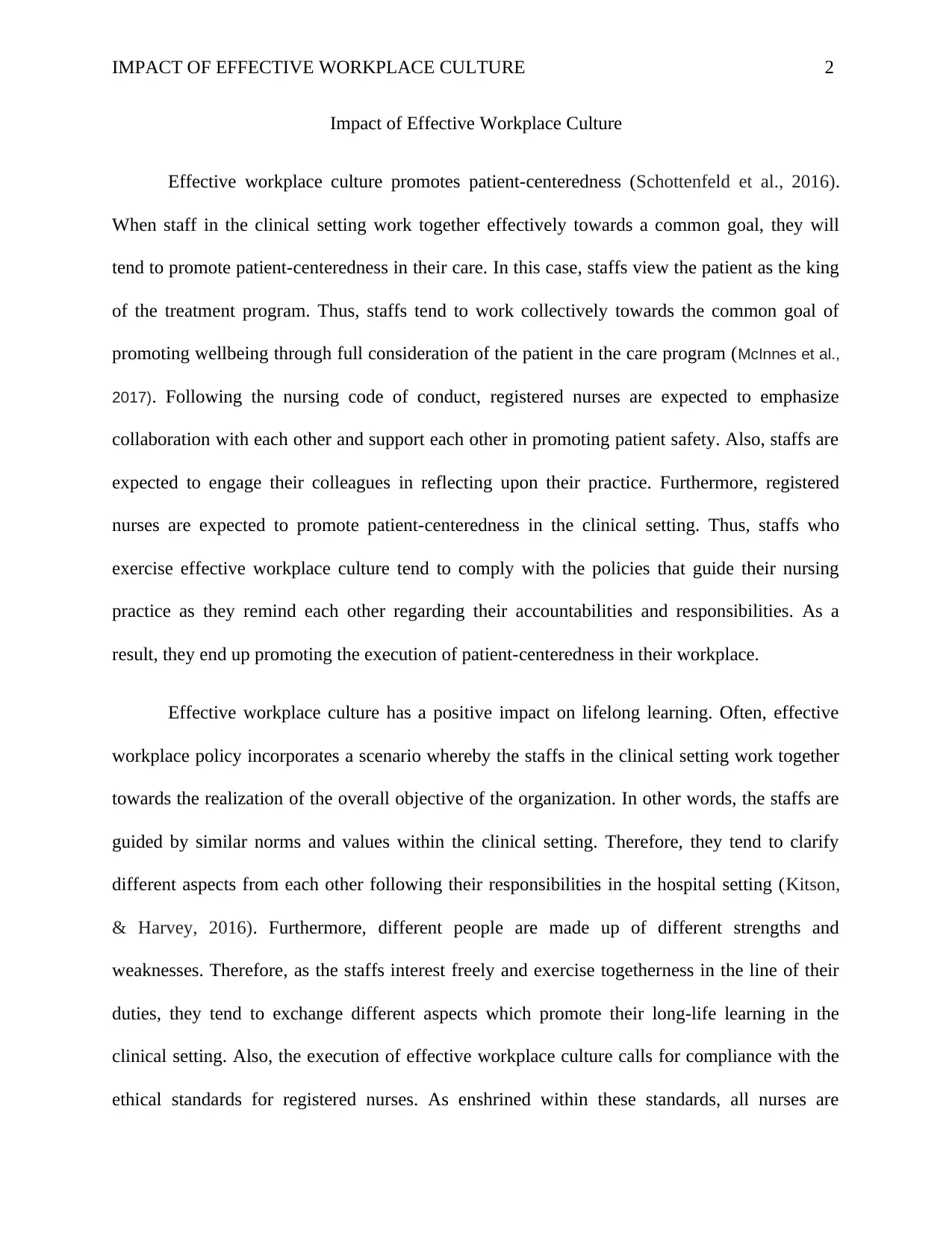
IMPACT OF EFFECTIVE WORKPLACE CULTURE 2
Impact of Effective Workplace Culture
Effective workplace culture promotes patient-centeredness (Schottenfeld et al., 2016).
When staff in the clinical setting work together effectively towards a common goal, they will
tend to promote patient-centeredness in their care. In this case, staffs view the patient as the king
of the treatment program. Thus, staffs tend to work collectively towards the common goal of
promoting wellbeing through full consideration of the patient in the care program (McInnes et al.,
2017). Following the nursing code of conduct, registered nurses are expected to emphasize
collaboration with each other and support each other in promoting patient safety. Also, staffs are
expected to engage their colleagues in reflecting upon their practice. Furthermore, registered
nurses are expected to promote patient-centeredness in the clinical setting. Thus, staffs who
exercise effective workplace culture tend to comply with the policies that guide their nursing
practice as they remind each other regarding their accountabilities and responsibilities. As a
result, they end up promoting the execution of patient-centeredness in their workplace.
Effective workplace culture has a positive impact on lifelong learning. Often, effective
workplace policy incorporates a scenario whereby the staffs in the clinical setting work together
towards the realization of the overall objective of the organization. In other words, the staffs are
guided by similar norms and values within the clinical setting. Therefore, they tend to clarify
different aspects from each other following their responsibilities in the hospital setting (Kitson,
& Harvey, 2016). Furthermore, different people are made up of different strengths and
weaknesses. Therefore, as the staffs interest freely and exercise togetherness in the line of their
duties, they tend to exchange different aspects which promote their long-life learning in the
clinical setting. Also, the execution of effective workplace culture calls for compliance with the
ethical standards for registered nurses. As enshrined within these standards, all nurses are
Impact of Effective Workplace Culture
Effective workplace culture promotes patient-centeredness (Schottenfeld et al., 2016).
When staff in the clinical setting work together effectively towards a common goal, they will
tend to promote patient-centeredness in their care. In this case, staffs view the patient as the king
of the treatment program. Thus, staffs tend to work collectively towards the common goal of
promoting wellbeing through full consideration of the patient in the care program (McInnes et al.,
2017). Following the nursing code of conduct, registered nurses are expected to emphasize
collaboration with each other and support each other in promoting patient safety. Also, staffs are
expected to engage their colleagues in reflecting upon their practice. Furthermore, registered
nurses are expected to promote patient-centeredness in the clinical setting. Thus, staffs who
exercise effective workplace culture tend to comply with the policies that guide their nursing
practice as they remind each other regarding their accountabilities and responsibilities. As a
result, they end up promoting the execution of patient-centeredness in their workplace.
Effective workplace culture has a positive impact on lifelong learning. Often, effective
workplace policy incorporates a scenario whereby the staffs in the clinical setting work together
towards the realization of the overall objective of the organization. In other words, the staffs are
guided by similar norms and values within the clinical setting. Therefore, they tend to clarify
different aspects from each other following their responsibilities in the hospital setting (Kitson,
& Harvey, 2016). Furthermore, different people are made up of different strengths and
weaknesses. Therefore, as the staffs interest freely and exercise togetherness in the line of their
duties, they tend to exchange different aspects which promote their long-life learning in the
clinical setting. Also, the execution of effective workplace culture calls for compliance with the
ethical standards for registered nurses. As enshrined within these standards, all nurses are
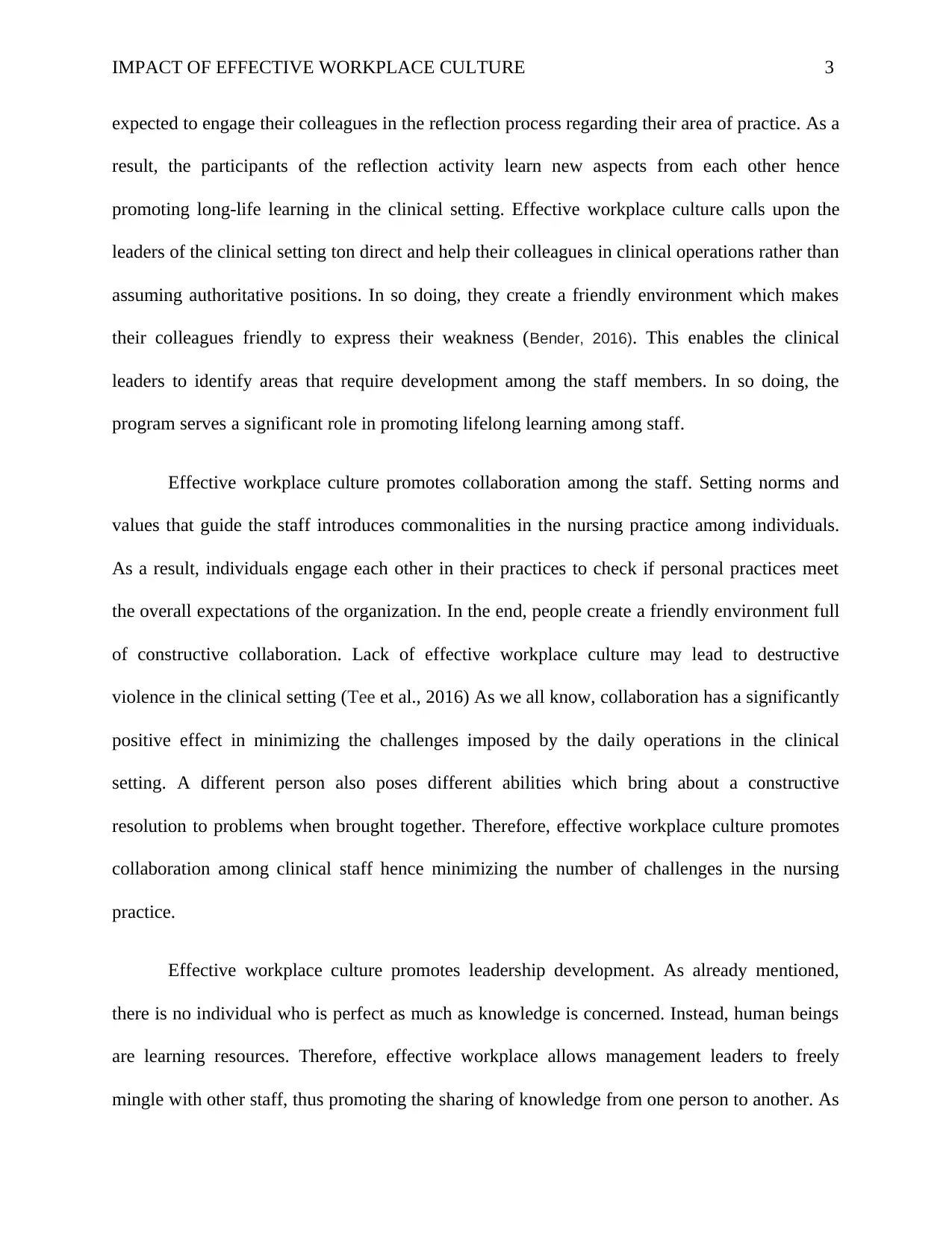
IMPACT OF EFFECTIVE WORKPLACE CULTURE 3
expected to engage their colleagues in the reflection process regarding their area of practice. As a
result, the participants of the reflection activity learn new aspects from each other hence
promoting long-life learning in the clinical setting. Effective workplace culture calls upon the
leaders of the clinical setting ton direct and help their colleagues in clinical operations rather than
assuming authoritative positions. In so doing, they create a friendly environment which makes
their colleagues friendly to express their weakness (Bender, 2016). This enables the clinical
leaders to identify areas that require development among the staff members. In so doing, the
program serves a significant role in promoting lifelong learning among staff.
Effective workplace culture promotes collaboration among the staff. Setting norms and
values that guide the staff introduces commonalities in the nursing practice among individuals.
As a result, individuals engage each other in their practices to check if personal practices meet
the overall expectations of the organization. In the end, people create a friendly environment full
of constructive collaboration. Lack of effective workplace culture may lead to destructive
violence in the clinical setting (Tee et al., 2016) As we all know, collaboration has a significantly
positive effect in minimizing the challenges imposed by the daily operations in the clinical
setting. A different person also poses different abilities which bring about a constructive
resolution to problems when brought together. Therefore, effective workplace culture promotes
collaboration among clinical staff hence minimizing the number of challenges in the nursing
practice.
Effective workplace culture promotes leadership development. As already mentioned,
there is no individual who is perfect as much as knowledge is concerned. Instead, human beings
are learning resources. Therefore, effective workplace allows management leaders to freely
mingle with other staff, thus promoting the sharing of knowledge from one person to another. As
expected to engage their colleagues in the reflection process regarding their area of practice. As a
result, the participants of the reflection activity learn new aspects from each other hence
promoting long-life learning in the clinical setting. Effective workplace culture calls upon the
leaders of the clinical setting ton direct and help their colleagues in clinical operations rather than
assuming authoritative positions. In so doing, they create a friendly environment which makes
their colleagues friendly to express their weakness (Bender, 2016). This enables the clinical
leaders to identify areas that require development among the staff members. In so doing, the
program serves a significant role in promoting lifelong learning among staff.
Effective workplace culture promotes collaboration among the staff. Setting norms and
values that guide the staff introduces commonalities in the nursing practice among individuals.
As a result, individuals engage each other in their practices to check if personal practices meet
the overall expectations of the organization. In the end, people create a friendly environment full
of constructive collaboration. Lack of effective workplace culture may lead to destructive
violence in the clinical setting (Tee et al., 2016) As we all know, collaboration has a significantly
positive effect in minimizing the challenges imposed by the daily operations in the clinical
setting. A different person also poses different abilities which bring about a constructive
resolution to problems when brought together. Therefore, effective workplace culture promotes
collaboration among clinical staff hence minimizing the number of challenges in the nursing
practice.
Effective workplace culture promotes leadership development. As already mentioned,
there is no individual who is perfect as much as knowledge is concerned. Instead, human beings
are learning resources. Therefore, effective workplace allows management leaders to freely
mingle with other staff, thus promoting the sharing of knowledge from one person to another. As
⊘ This is a preview!⊘
Do you want full access?
Subscribe today to unlock all pages.

Trusted by 1+ million students worldwide
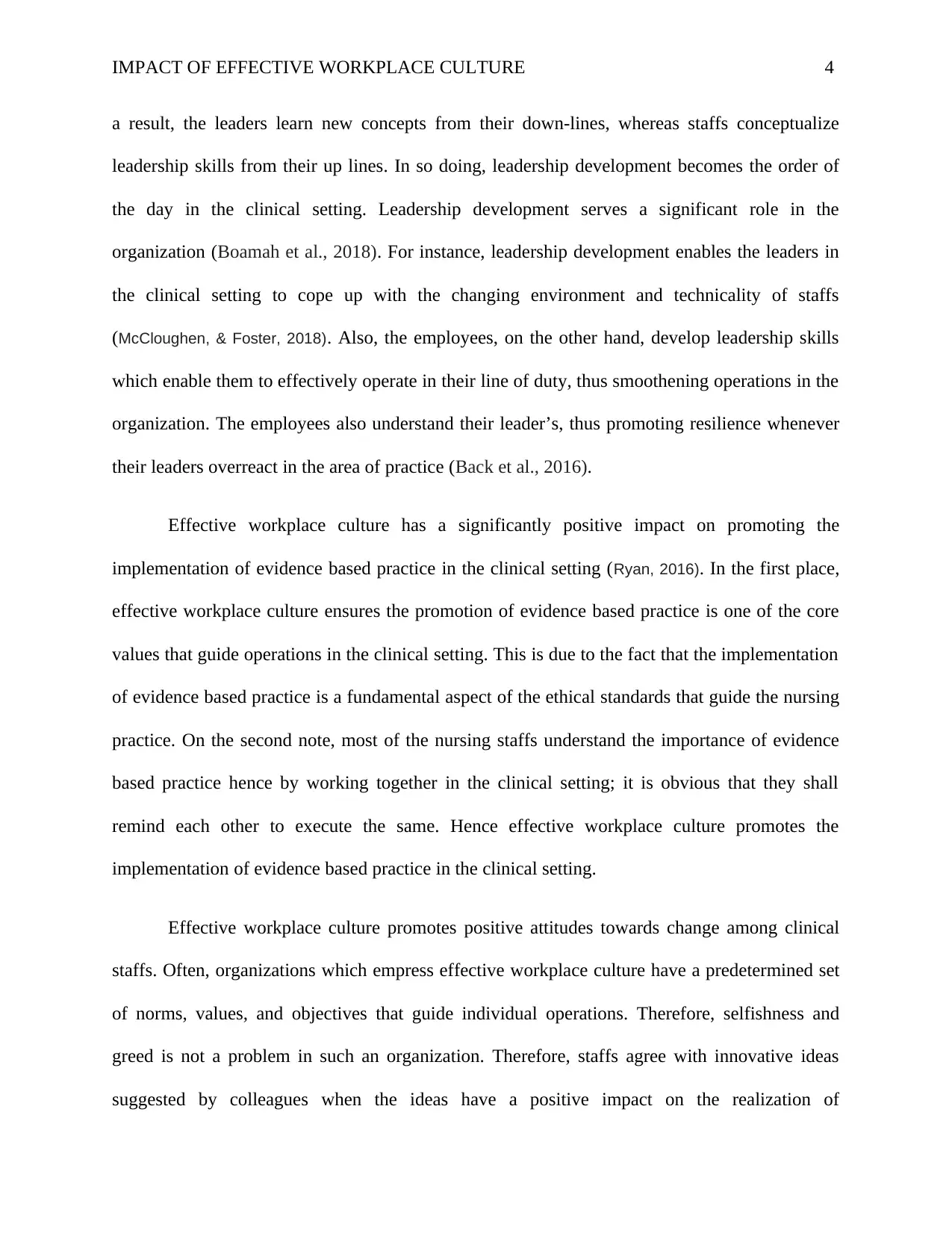
IMPACT OF EFFECTIVE WORKPLACE CULTURE 4
a result, the leaders learn new concepts from their down-lines, whereas staffs conceptualize
leadership skills from their up lines. In so doing, leadership development becomes the order of
the day in the clinical setting. Leadership development serves a significant role in the
organization (Boamah et al., 2018). For instance, leadership development enables the leaders in
the clinical setting to cope up with the changing environment and technicality of staffs
(McCloughen, & Foster, 2018). Also, the employees, on the other hand, develop leadership skills
which enable them to effectively operate in their line of duty, thus smoothening operations in the
organization. The employees also understand their leader’s, thus promoting resilience whenever
their leaders overreact in the area of practice (Back et al., 2016).
Effective workplace culture has a significantly positive impact on promoting the
implementation of evidence based practice in the clinical setting (Ryan, 2016). In the first place,
effective workplace culture ensures the promotion of evidence based practice is one of the core
values that guide operations in the clinical setting. This is due to the fact that the implementation
of evidence based practice is a fundamental aspect of the ethical standards that guide the nursing
practice. On the second note, most of the nursing staffs understand the importance of evidence
based practice hence by working together in the clinical setting; it is obvious that they shall
remind each other to execute the same. Hence effective workplace culture promotes the
implementation of evidence based practice in the clinical setting.
Effective workplace culture promotes positive attitudes towards change among clinical
staffs. Often, organizations which empress effective workplace culture have a predetermined set
of norms, values, and objectives that guide individual operations. Therefore, selfishness and
greed is not a problem in such an organization. Therefore, staffs agree with innovative ideas
suggested by colleagues when the ideas have a positive impact on the realization of
a result, the leaders learn new concepts from their down-lines, whereas staffs conceptualize
leadership skills from their up lines. In so doing, leadership development becomes the order of
the day in the clinical setting. Leadership development serves a significant role in the
organization (Boamah et al., 2018). For instance, leadership development enables the leaders in
the clinical setting to cope up with the changing environment and technicality of staffs
(McCloughen, & Foster, 2018). Also, the employees, on the other hand, develop leadership skills
which enable them to effectively operate in their line of duty, thus smoothening operations in the
organization. The employees also understand their leader’s, thus promoting resilience whenever
their leaders overreact in the area of practice (Back et al., 2016).
Effective workplace culture has a significantly positive impact on promoting the
implementation of evidence based practice in the clinical setting (Ryan, 2016). In the first place,
effective workplace culture ensures the promotion of evidence based practice is one of the core
values that guide operations in the clinical setting. This is due to the fact that the implementation
of evidence based practice is a fundamental aspect of the ethical standards that guide the nursing
practice. On the second note, most of the nursing staffs understand the importance of evidence
based practice hence by working together in the clinical setting; it is obvious that they shall
remind each other to execute the same. Hence effective workplace culture promotes the
implementation of evidence based practice in the clinical setting.
Effective workplace culture promotes positive attitudes towards change among clinical
staffs. Often, organizations which empress effective workplace culture have a predetermined set
of norms, values, and objectives that guide individual operations. Therefore, selfishness and
greed is not a problem in such an organization. Therefore, staffs agree with innovative ideas
suggested by colleagues when the ideas have a positive impact on the realization of
Paraphrase This Document
Need a fresh take? Get an instant paraphrase of this document with our AI Paraphraser
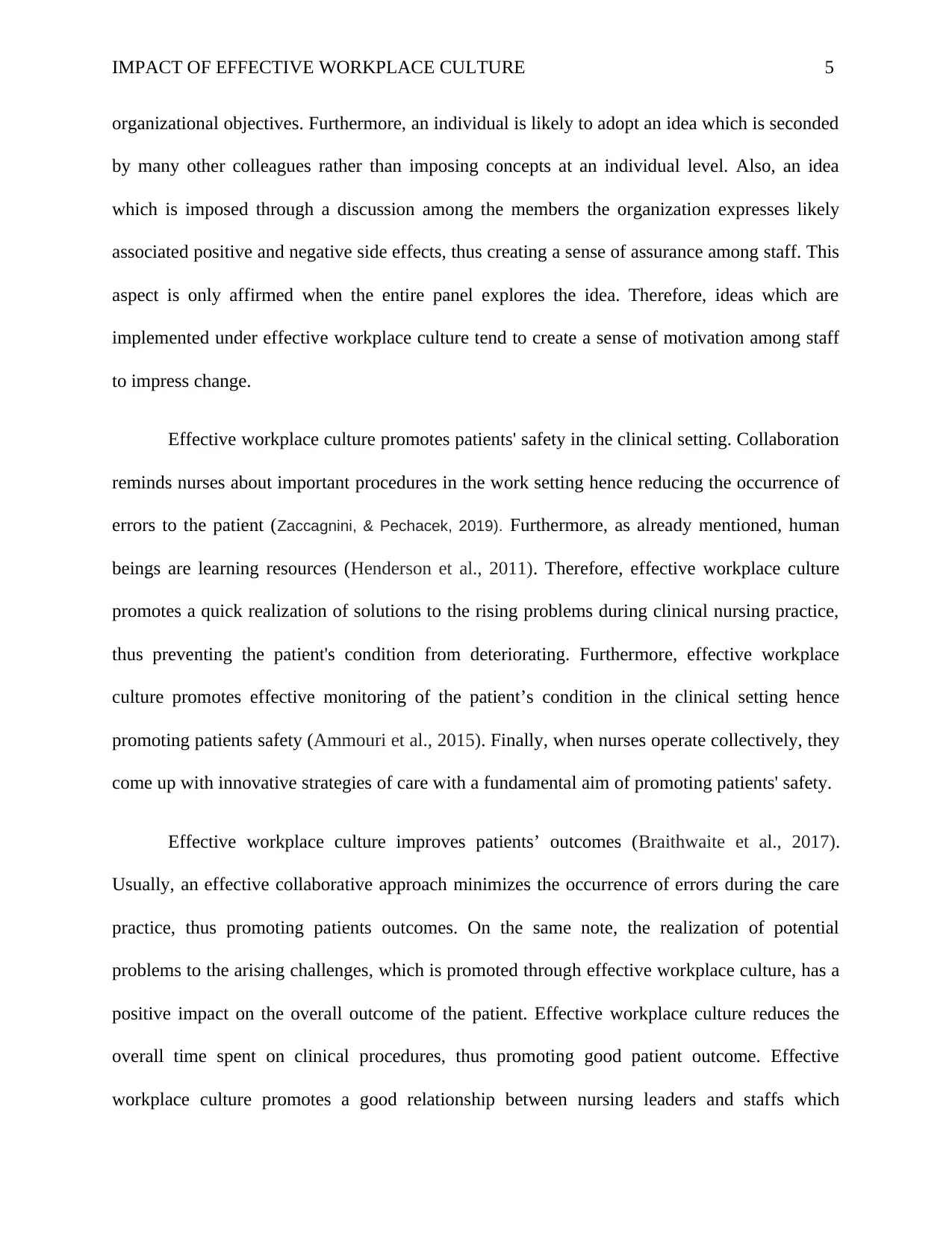
IMPACT OF EFFECTIVE WORKPLACE CULTURE 5
organizational objectives. Furthermore, an individual is likely to adopt an idea which is seconded
by many other colleagues rather than imposing concepts at an individual level. Also, an idea
which is imposed through a discussion among the members the organization expresses likely
associated positive and negative side effects, thus creating a sense of assurance among staff. This
aspect is only affirmed when the entire panel explores the idea. Therefore, ideas which are
implemented under effective workplace culture tend to create a sense of motivation among staff
to impress change.
Effective workplace culture promotes patients' safety in the clinical setting. Collaboration
reminds nurses about important procedures in the work setting hence reducing the occurrence of
errors to the patient (Zaccagnini, & Pechacek, 2019). Furthermore, as already mentioned, human
beings are learning resources (Henderson et al., 2011). Therefore, effective workplace culture
promotes a quick realization of solutions to the rising problems during clinical nursing practice,
thus preventing the patient's condition from deteriorating. Furthermore, effective workplace
culture promotes effective monitoring of the patient’s condition in the clinical setting hence
promoting patients safety (Ammouri et al., 2015). Finally, when nurses operate collectively, they
come up with innovative strategies of care with a fundamental aim of promoting patients' safety.
Effective workplace culture improves patients’ outcomes (Braithwaite et al., 2017).
Usually, an effective collaborative approach minimizes the occurrence of errors during the care
practice, thus promoting patients outcomes. On the same note, the realization of potential
problems to the arising challenges, which is promoted through effective workplace culture, has a
positive impact on the overall outcome of the patient. Effective workplace culture reduces the
overall time spent on clinical procedures, thus promoting good patient outcome. Effective
workplace culture promotes a good relationship between nursing leaders and staffs which
organizational objectives. Furthermore, an individual is likely to adopt an idea which is seconded
by many other colleagues rather than imposing concepts at an individual level. Also, an idea
which is imposed through a discussion among the members the organization expresses likely
associated positive and negative side effects, thus creating a sense of assurance among staff. This
aspect is only affirmed when the entire panel explores the idea. Therefore, ideas which are
implemented under effective workplace culture tend to create a sense of motivation among staff
to impress change.
Effective workplace culture promotes patients' safety in the clinical setting. Collaboration
reminds nurses about important procedures in the work setting hence reducing the occurrence of
errors to the patient (Zaccagnini, & Pechacek, 2019). Furthermore, as already mentioned, human
beings are learning resources (Henderson et al., 2011). Therefore, effective workplace culture
promotes a quick realization of solutions to the rising problems during clinical nursing practice,
thus preventing the patient's condition from deteriorating. Furthermore, effective workplace
culture promotes effective monitoring of the patient’s condition in the clinical setting hence
promoting patients safety (Ammouri et al., 2015). Finally, when nurses operate collectively, they
come up with innovative strategies of care with a fundamental aim of promoting patients' safety.
Effective workplace culture improves patients’ outcomes (Braithwaite et al., 2017).
Usually, an effective collaborative approach minimizes the occurrence of errors during the care
practice, thus promoting patients outcomes. On the same note, the realization of potential
problems to the arising challenges, which is promoted through effective workplace culture, has a
positive impact on the overall outcome of the patient. Effective workplace culture reduces the
overall time spent on clinical procedures, thus promoting good patient outcome. Effective
workplace culture promotes a good relationship between nursing leaders and staffs which
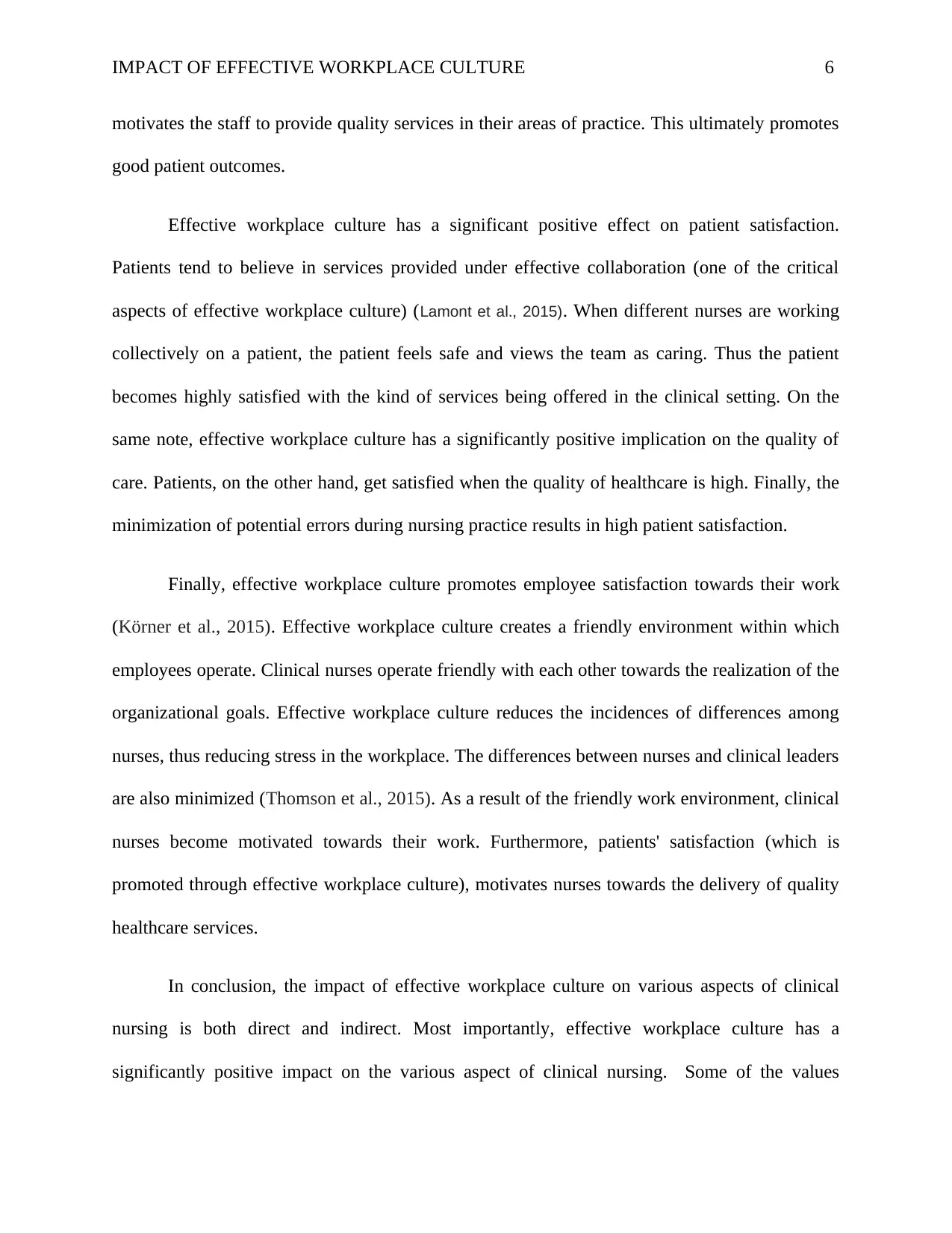
IMPACT OF EFFECTIVE WORKPLACE CULTURE 6
motivates the staff to provide quality services in their areas of practice. This ultimately promotes
good patient outcomes.
Effective workplace culture has a significant positive effect on patient satisfaction.
Patients tend to believe in services provided under effective collaboration (one of the critical
aspects of effective workplace culture) (Lamont et al., 2015). When different nurses are working
collectively on a patient, the patient feels safe and views the team as caring. Thus the patient
becomes highly satisfied with the kind of services being offered in the clinical setting. On the
same note, effective workplace culture has a significantly positive implication on the quality of
care. Patients, on the other hand, get satisfied when the quality of healthcare is high. Finally, the
minimization of potential errors during nursing practice results in high patient satisfaction.
Finally, effective workplace culture promotes employee satisfaction towards their work
(Körner et al., 2015). Effective workplace culture creates a friendly environment within which
employees operate. Clinical nurses operate friendly with each other towards the realization of the
organizational goals. Effective workplace culture reduces the incidences of differences among
nurses, thus reducing stress in the workplace. The differences between nurses and clinical leaders
are also minimized (Thomson et al., 2015). As a result of the friendly work environment, clinical
nurses become motivated towards their work. Furthermore, patients' satisfaction (which is
promoted through effective workplace culture), motivates nurses towards the delivery of quality
healthcare services.
In conclusion, the impact of effective workplace culture on various aspects of clinical
nursing is both direct and indirect. Most importantly, effective workplace culture has a
significantly positive impact on the various aspect of clinical nursing. Some of the values
motivates the staff to provide quality services in their areas of practice. This ultimately promotes
good patient outcomes.
Effective workplace culture has a significant positive effect on patient satisfaction.
Patients tend to believe in services provided under effective collaboration (one of the critical
aspects of effective workplace culture) (Lamont et al., 2015). When different nurses are working
collectively on a patient, the patient feels safe and views the team as caring. Thus the patient
becomes highly satisfied with the kind of services being offered in the clinical setting. On the
same note, effective workplace culture has a significantly positive implication on the quality of
care. Patients, on the other hand, get satisfied when the quality of healthcare is high. Finally, the
minimization of potential errors during nursing practice results in high patient satisfaction.
Finally, effective workplace culture promotes employee satisfaction towards their work
(Körner et al., 2015). Effective workplace culture creates a friendly environment within which
employees operate. Clinical nurses operate friendly with each other towards the realization of the
organizational goals. Effective workplace culture reduces the incidences of differences among
nurses, thus reducing stress in the workplace. The differences between nurses and clinical leaders
are also minimized (Thomson et al., 2015). As a result of the friendly work environment, clinical
nurses become motivated towards their work. Furthermore, patients' satisfaction (which is
promoted through effective workplace culture), motivates nurses towards the delivery of quality
healthcare services.
In conclusion, the impact of effective workplace culture on various aspects of clinical
nursing is both direct and indirect. Most importantly, effective workplace culture has a
significantly positive impact on the various aspect of clinical nursing. Some of the values
⊘ This is a preview!⊘
Do you want full access?
Subscribe today to unlock all pages.

Trusted by 1+ million students worldwide
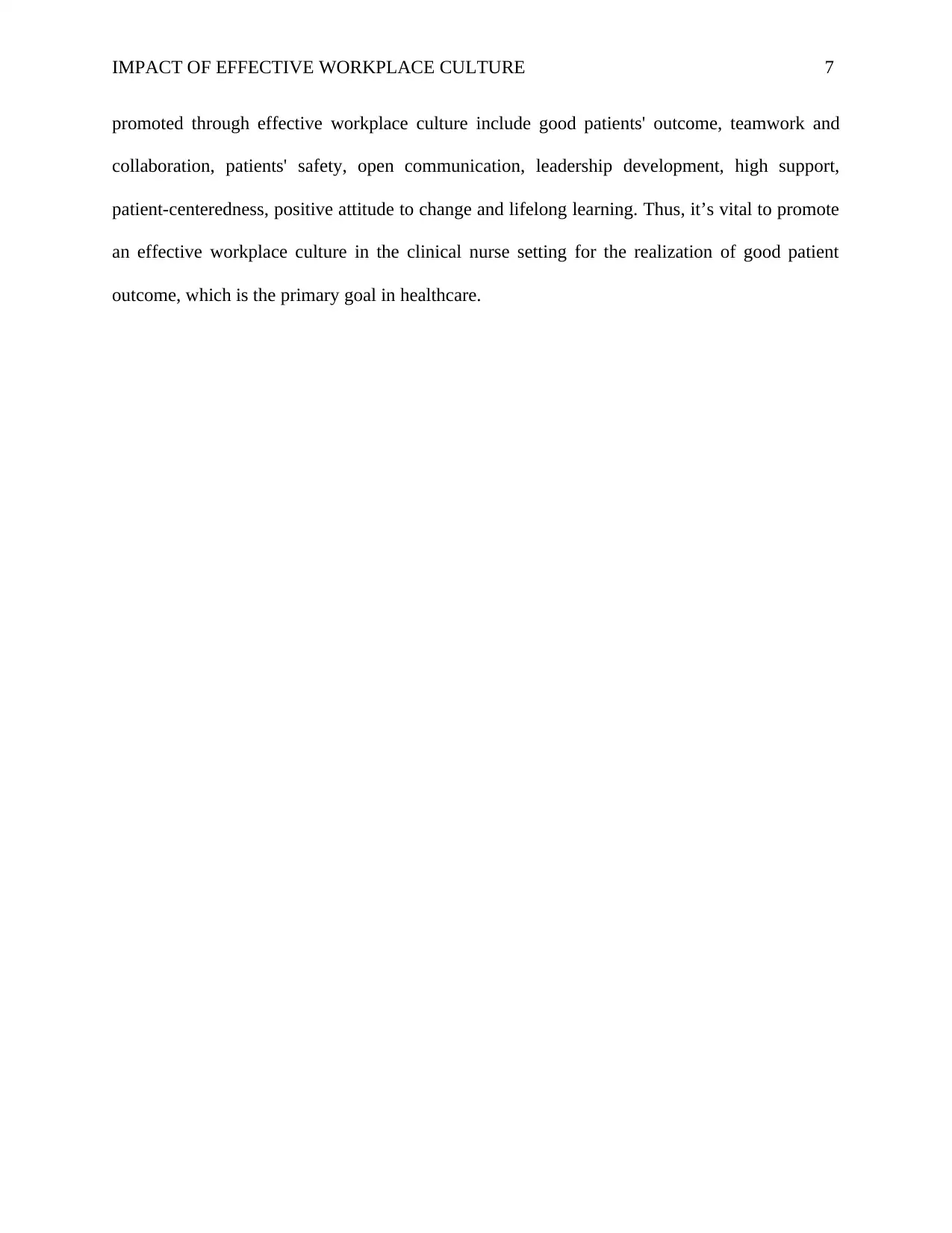
IMPACT OF EFFECTIVE WORKPLACE CULTURE 7
promoted through effective workplace culture include good patients' outcome, teamwork and
collaboration, patients' safety, open communication, leadership development, high support,
patient-centeredness, positive attitude to change and lifelong learning. Thus, it’s vital to promote
an effective workplace culture in the clinical nurse setting for the realization of good patient
outcome, which is the primary goal in healthcare.
promoted through effective workplace culture include good patients' outcome, teamwork and
collaboration, patients' safety, open communication, leadership development, high support,
patient-centeredness, positive attitude to change and lifelong learning. Thus, it’s vital to promote
an effective workplace culture in the clinical nurse setting for the realization of good patient
outcome, which is the primary goal in healthcare.
Paraphrase This Document
Need a fresh take? Get an instant paraphrase of this document with our AI Paraphraser
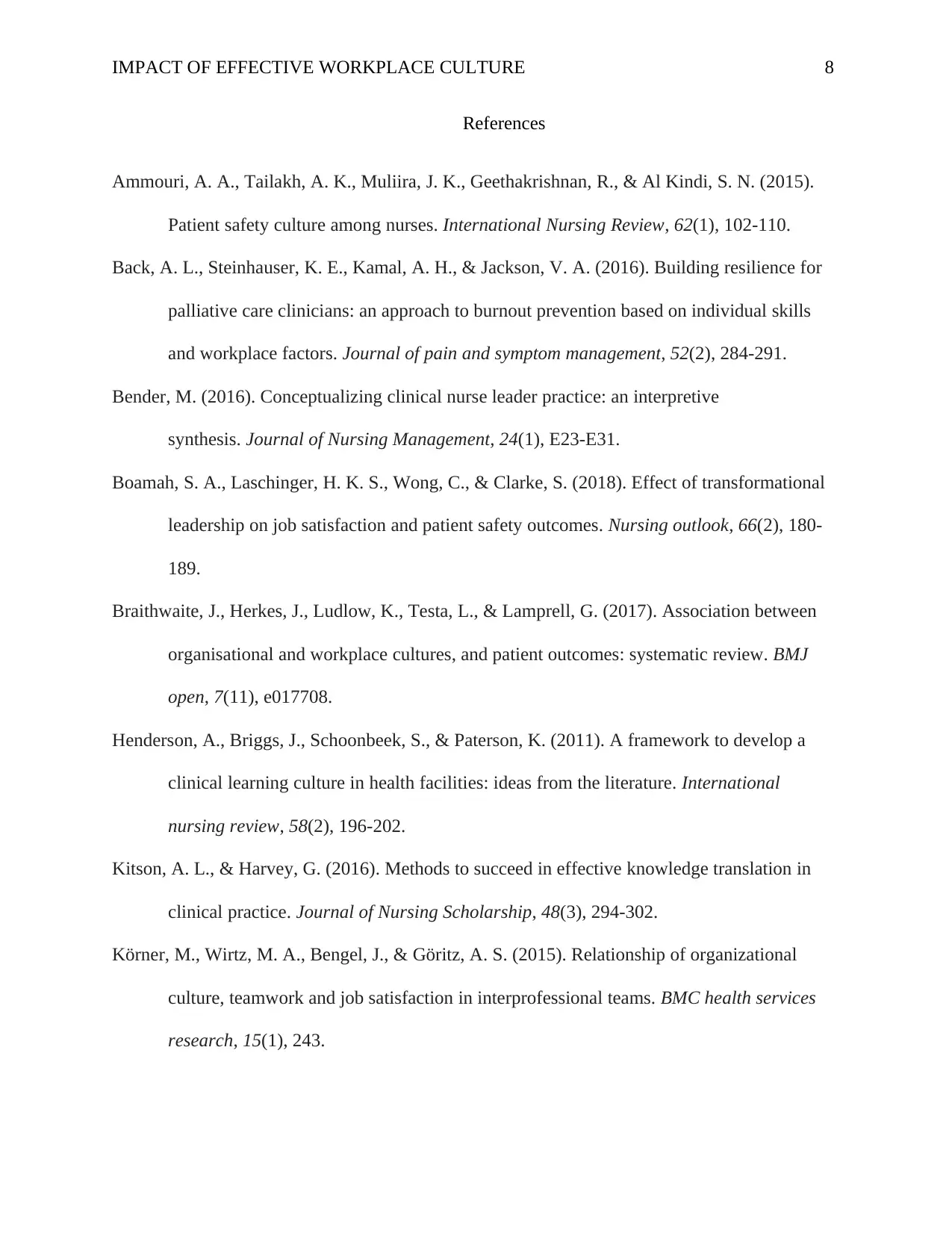
IMPACT OF EFFECTIVE WORKPLACE CULTURE 8
References
Ammouri, A. A., Tailakh, A. K., Muliira, J. K., Geethakrishnan, R., & Al Kindi, S. N. (2015).
Patient safety culture among nurses. International Nursing Review, 62(1), 102-110.
Back, A. L., Steinhauser, K. E., Kamal, A. H., & Jackson, V. A. (2016). Building resilience for
palliative care clinicians: an approach to burnout prevention based on individual skills
and workplace factors. Journal of pain and symptom management, 52(2), 284-291.
Bender, M. (2016). Conceptualizing clinical nurse leader practice: an interpretive
synthesis. Journal of Nursing Management, 24(1), E23-E31.
Boamah, S. A., Laschinger, H. K. S., Wong, C., & Clarke, S. (2018). Effect of transformational
leadership on job satisfaction and patient safety outcomes. Nursing outlook, 66(2), 180-
189.
Braithwaite, J., Herkes, J., Ludlow, K., Testa, L., & Lamprell, G. (2017). Association between
organisational and workplace cultures, and patient outcomes: systematic review. BMJ
open, 7(11), e017708.
Henderson, A., Briggs, J., Schoonbeek, S., & Paterson, K. (2011). A framework to develop a
clinical learning culture in health facilities: ideas from the literature. International
nursing review, 58(2), 196-202.
Kitson, A. L., & Harvey, G. (2016). Methods to succeed in effective knowledge translation in
clinical practice. Journal of Nursing Scholarship, 48(3), 294-302.
Körner, M., Wirtz, M. A., Bengel, J., & Göritz, A. S. (2015). Relationship of organizational
culture, teamwork and job satisfaction in interprofessional teams. BMC health services
research, 15(1), 243.
References
Ammouri, A. A., Tailakh, A. K., Muliira, J. K., Geethakrishnan, R., & Al Kindi, S. N. (2015).
Patient safety culture among nurses. International Nursing Review, 62(1), 102-110.
Back, A. L., Steinhauser, K. E., Kamal, A. H., & Jackson, V. A. (2016). Building resilience for
palliative care clinicians: an approach to burnout prevention based on individual skills
and workplace factors. Journal of pain and symptom management, 52(2), 284-291.
Bender, M. (2016). Conceptualizing clinical nurse leader practice: an interpretive
synthesis. Journal of Nursing Management, 24(1), E23-E31.
Boamah, S. A., Laschinger, H. K. S., Wong, C., & Clarke, S. (2018). Effect of transformational
leadership on job satisfaction and patient safety outcomes. Nursing outlook, 66(2), 180-
189.
Braithwaite, J., Herkes, J., Ludlow, K., Testa, L., & Lamprell, G. (2017). Association between
organisational and workplace cultures, and patient outcomes: systematic review. BMJ
open, 7(11), e017708.
Henderson, A., Briggs, J., Schoonbeek, S., & Paterson, K. (2011). A framework to develop a
clinical learning culture in health facilities: ideas from the literature. International
nursing review, 58(2), 196-202.
Kitson, A. L., & Harvey, G. (2016). Methods to succeed in effective knowledge translation in
clinical practice. Journal of Nursing Scholarship, 48(3), 294-302.
Körner, M., Wirtz, M. A., Bengel, J., & Göritz, A. S. (2015). Relationship of organizational
culture, teamwork and job satisfaction in interprofessional teams. BMC health services
research, 15(1), 243.
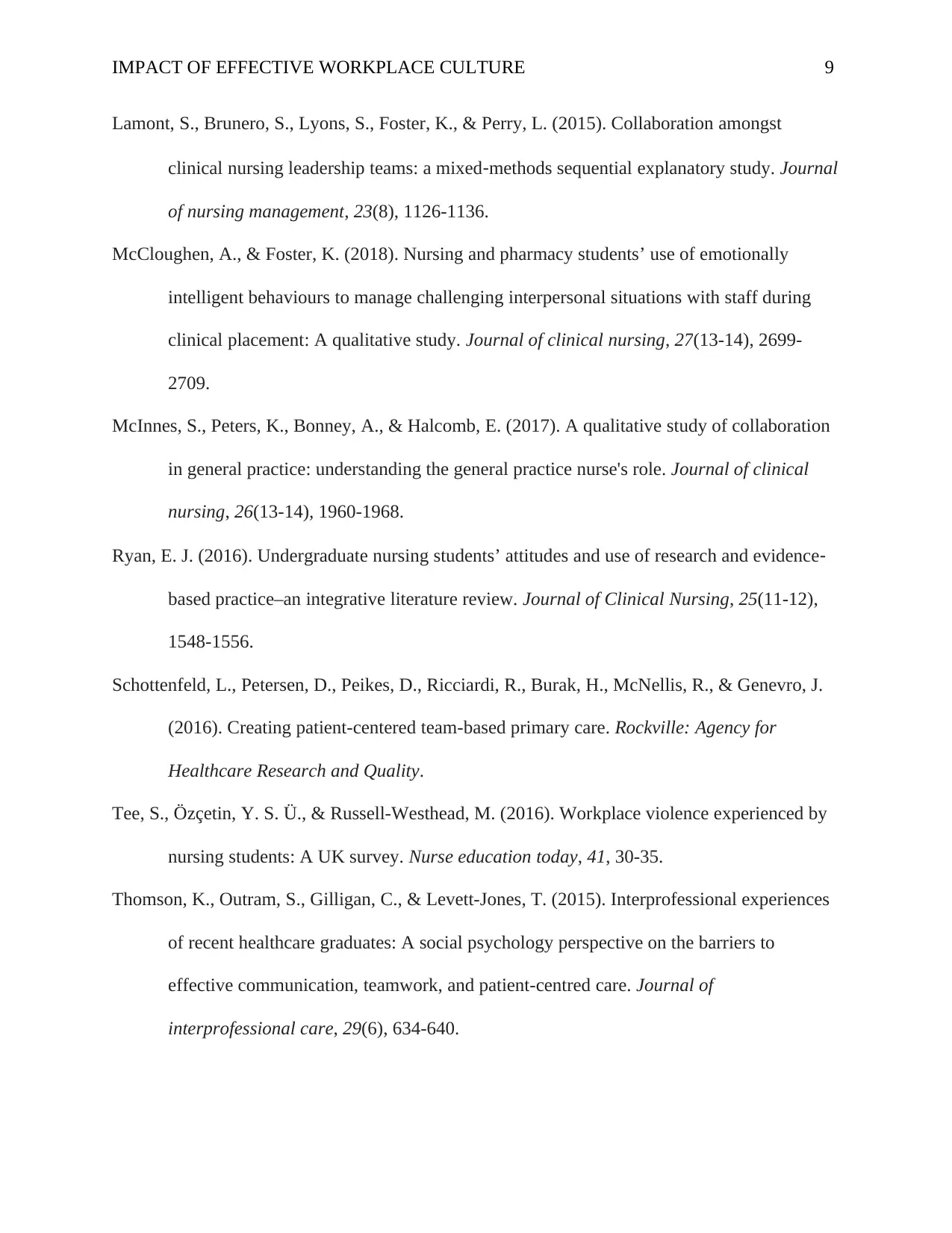
IMPACT OF EFFECTIVE WORKPLACE CULTURE 9
Lamont, S., Brunero, S., Lyons, S., Foster, K., & Perry, L. (2015). Collaboration amongst
clinical nursing leadership teams: a mixed‐methods sequential explanatory study. Journal
of nursing management, 23(8), 1126-1136.
McCloughen, A., & Foster, K. (2018). Nursing and pharmacy students’ use of emotionally
intelligent behaviours to manage challenging interpersonal situations with staff during
clinical placement: A qualitative study. Journal of clinical nursing, 27(13-14), 2699-
2709.
McInnes, S., Peters, K., Bonney, A., & Halcomb, E. (2017). A qualitative study of collaboration
in general practice: understanding the general practice nurse's role. Journal of clinical
nursing, 26(13-14), 1960-1968.
Ryan, E. J. (2016). Undergraduate nursing students’ attitudes and use of research and evidence‐
based practice–an integrative literature review. Journal of Clinical Nursing, 25(11-12),
1548-1556.
Schottenfeld, L., Petersen, D., Peikes, D., Ricciardi, R., Burak, H., McNellis, R., & Genevro, J.
(2016). Creating patient-centered team-based primary care. Rockville: Agency for
Healthcare Research and Quality.
Tee, S., Özçetin, Y. S. Ü., & Russell-Westhead, M. (2016). Workplace violence experienced by
nursing students: A UK survey. Nurse education today, 41, 30-35.
Thomson, K., Outram, S., Gilligan, C., & Levett-Jones, T. (2015). Interprofessional experiences
of recent healthcare graduates: A social psychology perspective on the barriers to
effective communication, teamwork, and patient-centred care. Journal of
interprofessional care, 29(6), 634-640.
Lamont, S., Brunero, S., Lyons, S., Foster, K., & Perry, L. (2015). Collaboration amongst
clinical nursing leadership teams: a mixed‐methods sequential explanatory study. Journal
of nursing management, 23(8), 1126-1136.
McCloughen, A., & Foster, K. (2018). Nursing and pharmacy students’ use of emotionally
intelligent behaviours to manage challenging interpersonal situations with staff during
clinical placement: A qualitative study. Journal of clinical nursing, 27(13-14), 2699-
2709.
McInnes, S., Peters, K., Bonney, A., & Halcomb, E. (2017). A qualitative study of collaboration
in general practice: understanding the general practice nurse's role. Journal of clinical
nursing, 26(13-14), 1960-1968.
Ryan, E. J. (2016). Undergraduate nursing students’ attitudes and use of research and evidence‐
based practice–an integrative literature review. Journal of Clinical Nursing, 25(11-12),
1548-1556.
Schottenfeld, L., Petersen, D., Peikes, D., Ricciardi, R., Burak, H., McNellis, R., & Genevro, J.
(2016). Creating patient-centered team-based primary care. Rockville: Agency for
Healthcare Research and Quality.
Tee, S., Özçetin, Y. S. Ü., & Russell-Westhead, M. (2016). Workplace violence experienced by
nursing students: A UK survey. Nurse education today, 41, 30-35.
Thomson, K., Outram, S., Gilligan, C., & Levett-Jones, T. (2015). Interprofessional experiences
of recent healthcare graduates: A social psychology perspective on the barriers to
effective communication, teamwork, and patient-centred care. Journal of
interprofessional care, 29(6), 634-640.
⊘ This is a preview!⊘
Do you want full access?
Subscribe today to unlock all pages.

Trusted by 1+ million students worldwide

IMPACT OF EFFECTIVE WORKPLACE CULTURE
10
Zaccagnini, M., & Pechacek, J. M. (2019). The doctor of nursing practice essentials: A new
model for advanced practice nursing. Jones & Bartlett Publishers.
10
Zaccagnini, M., & Pechacek, J. M. (2019). The doctor of nursing practice essentials: A new
model for advanced practice nursing. Jones & Bartlett Publishers.
1 out of 10
Related Documents
Your All-in-One AI-Powered Toolkit for Academic Success.
+13062052269
info@desklib.com
Available 24*7 on WhatsApp / Email
![[object Object]](/_next/static/media/star-bottom.7253800d.svg)
Unlock your academic potential
Copyright © 2020–2025 A2Z Services. All Rights Reserved. Developed and managed by ZUCOL.




